Healthy Fall Recipes – Mediterranean Diet
By George Zikos
Updated October 25, 2021
Transitioning into fall with the Mediterranean diet is easy. Since the Mediterranean diet is very seasonal, there is no shortage of great recipes for the cold weather coming. The winter in the Mediterranean is mild but it can still get very cold. There are many mountainous regions of the Mediterranean and the villages in these mountains have a cuisine that is influenced by their environment. You can find slow-cooked stews, slow roasted meats, homemade meat and vegetable pies, homemade pasta, and lots of potato, squash, and pumpkin recipes. We hope you enjoy these healthy fall recipes!

Lagkadia, Greece: A mountain village in the Peloponnese
In New England, a lot of the same ingredients that are available in the Mediterranean are available to us here in the fall. Some of the fresh fall ingredients that I love using in my Mediterranean cooking are pumpkin, squash, regular potatoes, sweet potatoes, leeks, kale, cabbage, chili peppers and mushrooms.
Mushrooms
In Bill Bradley’s travelogue from the Foods of Crete cookbook, he describes a mountain village in Crete that he could barely find because there was no sign. Luckily, he saw a man carrying hot plates of food into a small building so he decided to check it out. Another diner had brought freshly picked mushrooms for the chef to cook. The chef lightly floured them and fried them in extra virgin olive oil. Other than fried, mushrooms are so good roasted in the oven with fresh thyme, rosemary, lots of chopped garlic, and olive oil. An amazing Italian recipe with mushrooms for this time of year is pappardelle pasta with your favorite mushrooms, thyme, white wine, garlic, and your favorite cheese. This is an amazing Italian inspired pasta dish that is perfect for fall. Try Jamie Oliver’s version here:
Pappardelle with Mixed Wild Mushrooms
Pumpkin and Squash
In the Mediterranean, Pumpkin and squash are prepared in many different ways including layered into flaky phyllo dough, stuffed into ravioli, and roasted with lots of herbs and garlic just to name a few. Briam, a traditional Greek dish, in the summer contains potatoes, eggplant, zucchini, peppers, onions, tomatoes, and fresh herbs. In the winter the briam can change slightly and contain potatoes, sweet potatoes, eggplant, mushrooms, squash, onion, and more dried herbs. The same thing goes with the Ikarian dish, Soufico. Soufico is made by lightly frying sliced summer vegetables, layering them with fresh tomato, herbs, olive oil, and baking it all in the oven. In the winter, chili peppers and pumpkin substitute some of the summer vegetables. These are delicious Mediterranean recipes adapted by circumstance for the colder weather. Here’s are two popular pumpkin and squash recipes:
Quinoa, Feta, and Pistachio-Stuffed Acorn Squash

Pumpkin with Rosemary and Cinnamon

Leeks and Cabbage
Leeks and cabbage are two ingredients that remind me of the recipes prasorizo and lahanorizo from Greece. These are rice dishes with leeks and cabbage. You may have eaten the popular rice dish spanakorizo, or spinach with rice. All three of these recipes are flavored with olive oil, lemon, and dill. Prasorizo and lahanorizo are eaten almost strictly when it’s cold. Cabbage is also used in a very popular Greek dish, stuffed cabbage rolls. These are made the same way as stuffed grapeleaves, except they usually contain meat. This dish is also more popular when it’s cold. Leeks are also commonly cooked down in olive oil and then baked inside flaky phyllo dough. This savory pie is sold at bakeries all over Greece and it’s called prasopita.
Olive Tomato’s Prasorizo Recipe
The Greek Vegan’s Lahanorizo Recipe
Greens
Greens don’t love the summer heat, but in fall that morning dew and humidity, with the cooler temperatures is perfect for growing greens. I love the arugula in season during the fall. It’s the larger leaf variety of arugula that’s really spicy. What I love about it is, it’s spicy when it’s raw, but it’s very mild when cooked. I add it to soups, stews, omelets, salads, and sandwiches. There are lots of other greens available in fall, and there are so many Mediterranean diet recipes that feature greens like:
Horta and Potatoes
Sweet Tahini Vinaigrette with Grilled Romaine
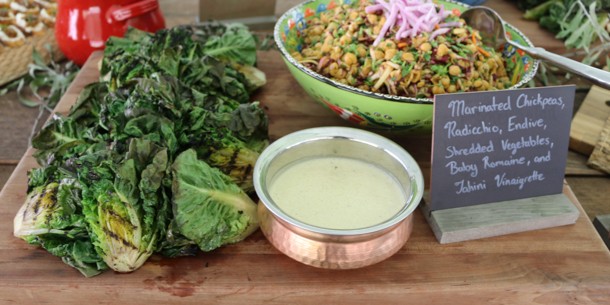
Sauteed Swiss Chard with Garlic
Roasted Fennel with Greens and Beans

Chili Peppers
The last ingredient I wanted to talk about was chili peppers. In general, Mediterranean people don’t eat a lot of spicy food, but in the winter they like to incorporate some heat. Chili peppers are added to soups and stews to add extra warmth in the winter months.
In Turkey, dried chilis are added to many savory dishes. A very traditional soup in Greece, fasolada, or white bean soup, is eaten year round. In the winter though, they will add some chili peppers to make it even more warming. Here’s a recipe for stuffed spicy cubanelle peppers with feta cheese. This is a perfect appetizer.
Spicy Stuffed Peppers with Feta
Drying and Preserving
Another way to transition into fall with the Mediterranean diet is to dry and preserve your fresh herbs, fruits, and vegetables. These dried herbs come in handy during the colder months to add layers of flavor to your roasted meats and vegetables, soups, stews, and salads. The herbs I like to dry are sage, thyme, rosemary, mint, and bay leaves. The trio of rosemary, thyme, and sage is usually thought of only for Thanksgiving. This is a shame because this herb trio can flavor so many more delicious dishes besides turkey. Just adding this herb trio to potatoes/sweet potatoes roasted in olive oil makes them so unbelievably savory and delicious. A lot of different fruits and vegetables are preserved that can be used in your Mediterranean cooking. Peppers, eggplant, chilis, beets, cauliflower, and cabbage are just some of the things you can preserve by fermenting. These are nice additions to fall salads or as mezes (tapas).
Autumn Spices
There are some very characteristic spices used in Mediterranean cooking in the fall that give the cuisine of this season characteristic aromas and flavors. Cinnamon sticks, cloves, allspice, star anise, smoked paprika, nutmeg, and ginger are the spices that give Mediterranean recipes their character in the fall. These spices are thrown into slow-cooked meats and stews that give them a heavenly aroma. These fall off the bone, melt in your mouth kind of stews are served over pasta or rice and sprinkled with grated cheese. This is Mediterranean comfort food, and the aromas of these spices stewing with meat bring back childhood memories for so many people. This is the kind of food your Grandmother made.
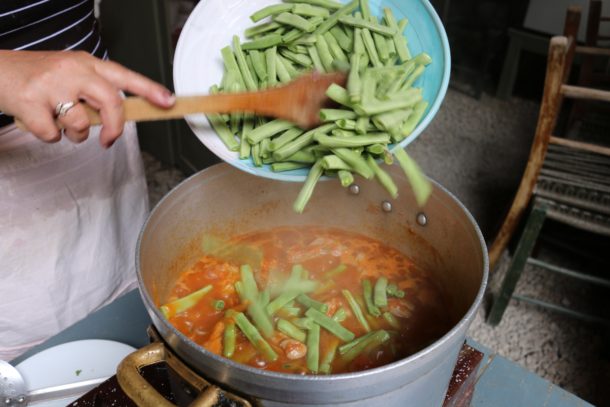
Slow-cooked pork with green beans

Dried orange peels
One of my favorite recipes that uses these spices is beef kokkinisto. The beef is cooked very slowly in wine, olive oil, tomato sauce, cinnamon, cloves, and allspice. Another classic Greek comfort food that uses some of these spices is Moussaka. The ground beef in Moussaka is cooked with red wine, cinnamon, and cloves, giving it a signature taste. One more dish that can’t be forgotten, one of my favorites, giouvetsi. This is a very traditional Greek dish that is baked in outdoor ovens. It consists of orzo, veal or lamb, carrots, red wine, and cinnamon. My Aunt in Crete puts a dried orange peel in too which gives it an amazing citrus undertone. If you’ve never tried giouvetsi, here’s a great recipe for it.
Akis Petretzikis Giouvetsi Recipe
One Pot Meals
The summer grilling is over and while we may still use our grill, we are definitely transitioning to more one-pot meals. Mediterranean cooking is absolutely perfect for one-pot meals. It’s hard to go wrong when you begin with olive oil, onions, garlic, and chopped tomatoes. With the addition of vegetables, meat, herbs and spices, you can make a filling and delicious one-pot meal. Here are some awesome one-pot Mediterranean recipes to try:
Beef Cacciatore

Photo by Christine Dutton
Beef Stew with Eggplant, Zucchini, and Tomatoes (Greece)

Photo by Christine Dutton
Chicken Tagine with Peppers and Olives
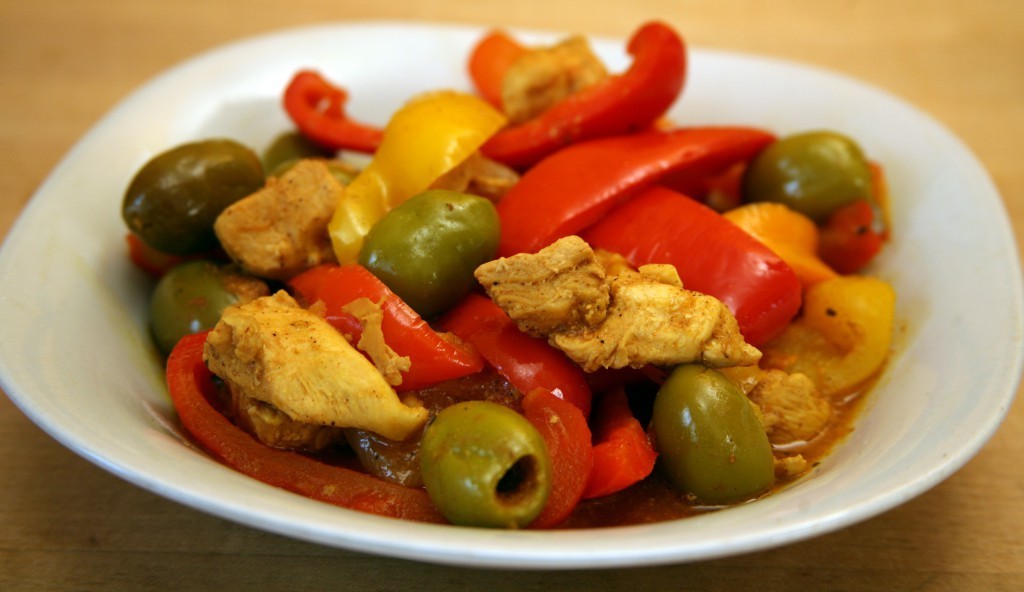
Photo By Bill Bradley
If you have an Instant Pot, try these out!:
Instant Pot Beef Stew with Sage and Red Wine

Instant Pot Black Eyed Peas with Fresh Dill and Parsley

Instant Pot Fasolakia (Green Beans and Potatoes in Olive Oil)
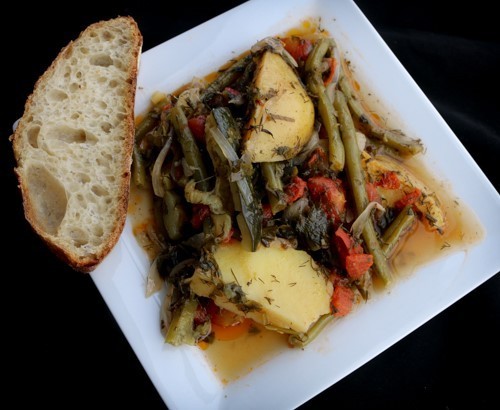
I hope with this article and recipes, you realize that eating Mediterranean in the fall is an easy transition from summer. A whole new selection of fresh fruits and vegetables are available, as well as a time for drying and preserving in order to last the winter. Mediterranean cooking in fall will open your eyes to a whole new side of Mediterranean cuisine.

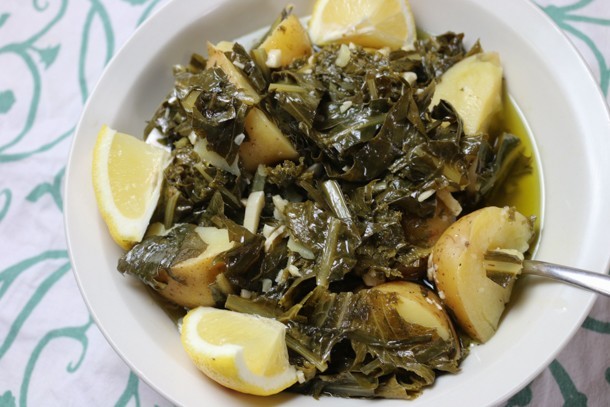













Bill Bradley, R.D. says:
Bill Bradley, R.D. says:
Bill Bradley, R.D. says: